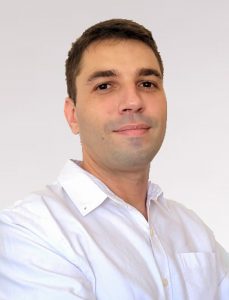Geostatistical simulations, what for? Geovariances’ consultants give examples of use
Posted on We asked some of our consultants to tell us about recent studies in which they used conditional simulations for specific issues. Here are the examples they gave us.

What was Weda Bay Nickel’s main issue?
Weda Bay Nickel requested a geostatistical workflow for recoverable resource estimation of their lateritic nickel deposits in Indonesia. We proposed a solution based on geostatistical simulation to generate realizations (multiple facies and grades). Post-processing the realizations permitted us to calculate the cut-off-based tonnages and the associated probability for the grades to exceed the cut-offs, in addition to the facies proportion in each SMU.
What simulation technique(s) did you use?
We first used the Plurigaussian simulation for lithofacies modeling to provide geological domains needed for resource estimation. We then ran Turning Bands simulations for generating ferro-nickel grades conditioned to the generated facies domains and chemical analyses.
What were the results?

What was the client’s main issue?
The open pit gold mine exploitation was close to the end because of a long history of exploitation. The client contacted Geovariances to prepare an extension to underground mining. The goal was to anticipate the rock properties and optimize future mine exploitation. The planned mine extension was in the same geological environment as the open pit and was sampled by several exploration drillholes.
What simulation technique(s) did you use?
From a geological point of view, the mine extension is expected to be similar to the current open pit. Therefore, we proposed to use the MPS (Multiple-point Statistics) technique. The idea was to create a 3D model training image from the reconciliation model, which could be considered a realistic numerical representation of the open pit.
MPS (Multiple Point Statistics) allowed generating 3D numerical models resembling the training image, which corresponded to the company’s goal. In addition, it was possible to fit the spatial evolution of the geological environment by using scaling factors or local rotation angles. This machine-learning-like method is quite easy to understand and manage, valorize the existing models, and is flexible enough to customize the resulting models. It is simple enough in practice to be used on-site.
What were the results?
With this approach, it was possible to build a realistic model of the future underground extension, looking like the already produced mineralization, conditioned by the available exploration samples.
MPS can also be used to characterize mineralizations away from an existing mine, considering geological trends.

What was the client’s main issue?
The mine had a problem with finding more ore than expected from the existing numerical models. It was generating trouble for predicting revenues and for dimensioning the production plant. According to geologists’ interpretation, a possible source of this problem was the lack of small mineralized lenses in the current model. Mineralized lenses were often smaller than boreholes spacing, and a significant amount of mineralized volume was possibly missing in the estimations.
What simulation technique(s) did you use?
The challenge was to create a realistic geological model looking like the existing one but with more mineralized bodies.
We suggested using MPS (Multiple-point Statistics), the current reference model being considered as the training image, and scaling factors in the three space directions being used to increase the number of mineralized bodies. The effect of scaling factors is to generate models similar to the training image but with more mineralized lenses of smaller size.
What were the results?
The grade tonnage curves calculated in the new model were different than the ones calculated from the initial model, with more metal quantity, as expected. It was then possible to fit the scaling factor to the observed production.

What was the client’s main issue?
The client requested a guide to resource classification based on grade uncertainty and production period, which would help them define their sampling budget.
What simulation technique(s) did you use?
We proposed Drill Hole Spacing Analysis, which consists in analyzing the grade uncertainty of a simulated reality. This new reality is obtained with conditional simulation (Turning Bands) and sampled according to different virtual meshes. We access the grade uncertainty for each virtual sampling in each production period by simulating grades on the virtual drill holes given the production plan. In the end, based on Verly and Parker (2014), we derive the drill hole spacing related to measured and indicated mineral resources, which was precisely the result that the client needed.
It is essential to mention that the simulated reality honors the statistical and geostatistical behavior of the original samples.
What were the results?
The client realized that the spacing they considered for what they deemed indicated resources was too tight and, in fact, more in accordance with measured resources.
The measured resources (already sampled with tight spacing) were higher with the new results. As a matter of fact, the study enabled them to better plan the future sampling budget.
And as a secondary result, we also identified areas with higher uncertainty and proposed a new sampling plan priority and mine planning.

What was the mining company’s main issue?
The client reached out to Geovariances to develop a workflow for automatic domain modeling and volumetric uncertainty assessment in stratigraphic bauxite plateaus.
What simulation technique(s) did you use?
We used Machine Learning-based techniques to group the samples into domains in a first step.
Then, we interpolated and triangulated the contacts between the different defined domains throughout the study area.
To assess the volumetric uncertainty, we simulated realizations of the contacts by disturbing the interpolated surfaces, pushing or pulling them vertically from several meters on each grid cell before the triangulation. We used SGSIM to simulate a two-dimensional Gaussian field. Obtaining the perturbance vectors from a Gaussian field ensures that the simulated surface varies smoothly around the interpolated surface.
What were the results?
The proposed workflow produced consistent and realistic results and allowed the customer to test different domain configurations and quickly assess volumetric uncertainty in an automatic way.
Mining (14)
Nuclear Decommissioning (9)
Contaminated sites (7)
Oil & Gas (6)
Hydrogeology (5)
TAGS:
2D/3D (2)
Background images (1)
Big data (1)
Conditional simulations (7)
Contaminated sites (2)
Contamination (2)
Drill Hole Spacing Analysis DHSA (3)
Excavation (2)
Facies modeling (2)
Flow modeling (1)
Geological modeling (3)
Gestion des sites pollués (2)
H2020 INSIDER (1)
Horizon mapping (1)
Ice content evaluation (1)
Isatis (11)
Isatis.neo (16)
Kartotrak (8)
Machine Learning (2)
Mapping (3)
MIK (2)
Mineral resource estimation (7)
Monitoring network optimization (1)
MPS (2)
Ore Control (1)
Pareto (2)
Pollution (2)
Post-accidental situation (2)
Recoverable resource estimation (3)
Resource classification (2)
Resources workflow (1)
Resource workflow (3)
Risk analysis (3)
Sample clustering (1)
Sampling optimization (3)
Scripting procedures (3)
Simulation post-processing (1)
Site characterization (2)
Soil contamination mapping (4)
Time-to-Depth conversion (1)
Uncertainty analysis (2)
Uniform Conditioning (5)
Variography (2)
Volumes (2)
Water quality modeling (1)
AUTHORS:
David Barry (3)
Pedram Masoudi (2)
Yvon Desnoyers (2)
Catherine BLEINES (1)
Pedro Correia (1)
DATES:
2023 (2)
2022 (3)
2021 (2)
2020 (2)
2019 (8)
2018 (4)
2017 (3)
2016 (3)